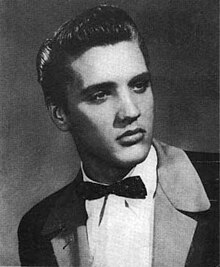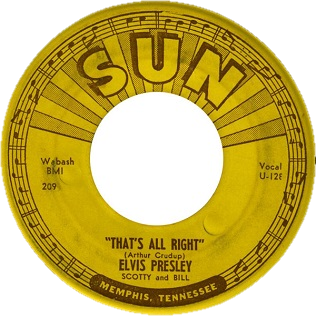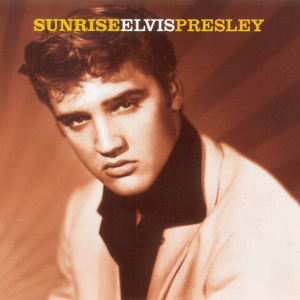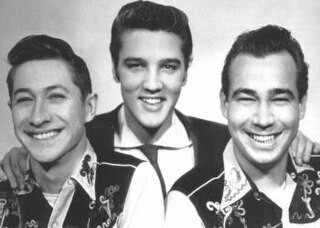Recordings
On July 18, 1953, Presley first went to the Memphis Recording Service at the Sun Record Company, now commonly known as Sun Studio. [2] He paid $3.98 to record the first of two double-sided demo acetates, "My Happiness" and "That's When Your Heartaches Begin". Presley reportedly gave the acetate to his mother as a much-belated extra birthday present, [3] although many biographers suggest that Presley simply wanted to get noticed by Sun owner Sam Phillips. These suggestions are strengthened by the fact that the Presleys did not own a record player at the time. [4] [5] Elvis could have wanted both : another gift for his mother and an opportunity to be discovered. That one-off acetate has since been valued at $500,000 by Record Collector magazine. Returning to Sun Studios on January 4, 1954, he recorded a second acetate, "I'll Never Stand in Your Way" / "It Wouldn't Be the Same Without You". [6]
Phillips had already cut the first records by blues artists such as Howlin' Wolf and Junior Parker. [7] He thought a combination of black blues and boogie-woogie music would be very popular among white people, if presented in the right way. [8] In the spring, Presley auditioned for an amateur gospel quartet called The Songfellows, as one of the group was leaving and they were seeking a replacement. [9] However, following Presley's audition, the original group member decided to stay. [9] In May, Presley auditioned at the Hi-Hat in Memphis as a vocalist for a band. Eddie Bond, the owner of the Hi-Hat, turned him down. [10]
When Phillips acquired a demo recording of "Without You" and was unable to identify the vocalist, his assistant, Marion Keisker, reminded him about the young truck driver. She called him on May 26, 1954. Presley was not able to do justice to the song (the original acetate of the song that Phillips presented to Elvis resides in the Memphis State University collection), [11] but Phillips asked him to perform some of the many other songs he knew. After running through a few songs, Presley expressed an interest in finding a band to play with, and Phillips invited local Western swing musicians Winfield "Scotty" Moore (electric guitar) and Bill Black (slap bass) to audition Presley. They did so on Sunday, July 4, 1954, at Moore's house. Neither musician was overly impressed, but they agreed a studio session would be useful to explore his potential. [12]
On July 5, 1954, the trio met at Sun studios to rehearse and record a handful of songs. According to Moore, the first song they recorded was "I Love You Because", but, after a few other country-oriented songs that weren't all that impressive, they decided to take a break. [13] During the break, Presley began "acting the fool" with Arthur Crudup's "That's All Right (Mama)", a blues song. [14] When the other two musicians joined in, Phillips got them to restart and began taping. This was the bright, upbeat sound he had been looking for. [15] Black remarked, "Damn. Get that on the radio and they'll run us out of town." [16] The group recorded four songs during that session, including bluegrass musician Bill Monroe's "Blue Moon of Kentucky", which he had written and recorded as a slow waltz. Sources credit Bill Black with initiating the song, with Presley and Moore joining in. They ended up with a fast version of the song in 4/4 time. After an early take, Phillips can be heard on tape saying: "Fine, man. Hell, that's different—that's a pop song now, nearly 'bout." [17]
To gauge professional and public reaction, Phillips took several acetates of the session to DJ Dewey Phillips (no relation) of Memphis radio station WHBQ's Red, Hot and Blue show. "That's All Right" subsequently received its first play on July 8, 1954. [18] A week later, Sun had received some 6,000 advanced orders for "That's All Right" / "Blue Moon of Kentucky," which was released on July 19, 1954. From August 18 through December 8, "Blue Moon of Kentucky" was consistently higher on the charts, and then both sides began to chart across the South. [19]
After several performances with other bands, Presley arranged for Moore and Black to be his regular back-up group, giving them each 25% of the takings. [20] Moore and Black were originally members of their own band, The Starlight Wranglers, but after the success of "That's All Right", jealousy within the group forced them to split. [21]
Over the next 15 months, the trio would release five singles, tour extensively across the South, and appear regularly on the Louisiana Hayride; it was the biggest rival to the Grand Ole Opry at the time. They had originally auditioned for the Opry in October 1954, but they failed to impress the people in charge, or the audience, and were not invited back. Several biographers cite Jim Denny, talent agent at the Opry, as the man who told Presley that he should "go back to driving a truck". [22]
The trio would record at Sun together until November 1955, when RCA Victor purchased Presley's Sun contract from Phillips for $40,000; it was, at the time, the highest sum ever paid for a recording contract. Sun's rights to press Presley's recordings expired on January 1, 1956; RCA Victor then issued Presley's first five Sun singles nationally. Presley's first single for RCA Victor, "Heartbreak Hotel" was recorded in January, 1956. Although no longer under contract to Sun, Presley returned to the studios frequently over the next few months, visiting with Phillips and meeting many of the label's new artists.
On December 4, 1956, Presley visited Sun studios during a Carl Perkins recording session, which also featured a young Jerry Lee Lewis on piano, and a new artist named Johnny Cash looking on. During a break in recording, Presley sat at the piano and began to sing along with Perkins, Lewis and Cash. Phillips kept his tape recorder running during the impromptu jam session and seeing an opportunity to promote another of his new acts, he arranged for a reporter to cover the event. The recordings would eventually surface later as "The Million Dollar Quartet".
During Presley's tenure at Sun Records, he recorded two demo recordings in Lubbock, Texas: "Fool, Fool, Fool" and "Shake, Rattle and Roll", which were released for the first time by RCA Victor in the 1990s. These are not considered Sun recordings.

















